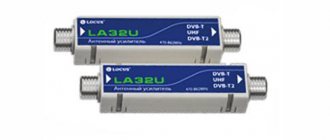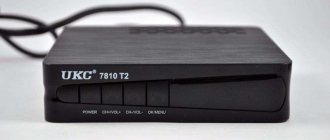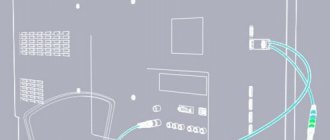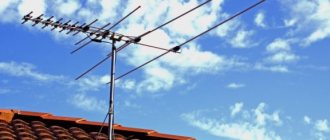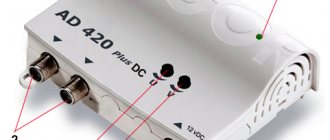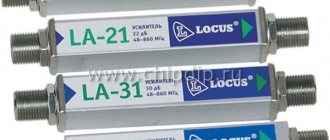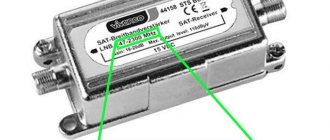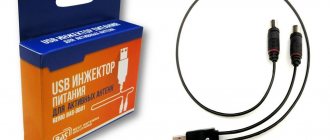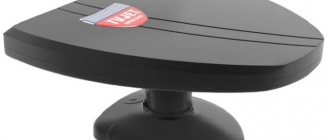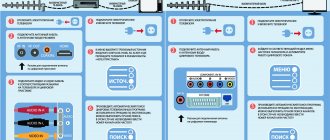A weak television signal, which spoils the “picture” on the TV screen, can be easily amplified using a special device. This simple but effective invention is called an antenna amplifier. It reduces the level of interference, the image becomes high quality.
The editors of the Yanashla website bring to your attention a review of high-quality signal amplifiers for TV antennas for 2021 and recommendations for choosing this equipment.
What types of amplifiers are there?
Devices that amplify television signals vary in classification and design.
There are devices for digital TV antennas and for analog signals. They have a power supply, both external and internal. The external unit is larger than the internal one, its input voltage depends on the amplifier, and can consume 5, 12, 18 or 24 V. The internal unit consumes up to 10 V, it requires a stable voltage of electricity. It may fail during power surges. If the unit burns out, you will have to replace the entire antenna completely.
Types of amplifiers depending on the received frequency
Devices according to classification are distinguished into:
- Broadband
These models are capable of covering a wide range of amplified frequencies. As a rule, they are used if the TV antenna signal is good, but does not provide an ideal image.
- Band
Designed to receive frequencies either meter (MV) - from 30 to 300 MHz, or decimeter (UHF) - from 300 to 3000 MHz. Can be used if the TV signal is very weak. Digital TV requires a UHF frequency range.
- Multi-band
Models with separate adjustment of different ranges.
According to the required voltage, they are divided into the following types:
- Five-volt.
They are connected using a coaxial cable and attached to the antenna.
- Twelve volt.
These devices work with a power supply.
Advice from professionals
During the assembly and installation of the signal amplifier, it is necessary to take into account not only the recommendations of the manufacturers, but also follow the advice of professionals. They will help you avoid most simple mistakes and achieve the desired result in a minimum amount of time.
Key recommendations from experts:
- The antenna amplifier must be located in close proximity to the TV. This is done in order to reduce cable losses, which can cause deterioration in the quality of the television picture.
- It is not recommended to equip indoor antennas with signal amplifiers, as this will not provide any benefits and will not eliminate interference.
- Before using the device, be sure to study the included instructions in detail. This information will help you install the device correctly and reduce the likelihood of installation errors.
- If the installed amplifier does not solve the problem, then the cause of poor signal quality should be sought in the antenna itself, its location and correspondence to wave frequencies.
- Any installation, repair or maintenance work on the device should be carried out only after it has been disconnected from the power source. There is a high risk of electric shock.
- It is prohibited to connect the signal amplifier to antennas located on the roof of a building or in rooms not equipped with lightning protection. If you neglect this advice, you may lose not only the amplifier, but also the TV.
- Do not connect a device that has visible damage to the housing, as this will increase the risk of electric shock.
A TV signal amplifier is a useful and inexpensive device. With its help, you can eliminate various interference and significantly improve the quality of the television picture. With the right approach to choosing a device and following all the recommendations of professionals, you can achieve the desired result and reduce the likelihood of malfunctions.
Pros and cons of TV signal amplifiers
According to experts, the advantages of using amplifiers are:
- Noise coefficients are negligible;
- Very weak TV signals are being received;
- You can amplify the signal in several ranges simultaneously.
But where there are pros, there are always cons:
- When using a “broadband”, you can overload the required signal level;
- Afraid of thunderstorms;
- The TV signal may be lost;
- Greater sensitivity.
It is important not to forget that this device is not a super-device; it only performs correction functions, helping the TV antenna to “fix” a good signal.
Models for analog signal amplification
Modern radio technology devices can solve the problem of poor quality “picture” on your TV screen. Such devices have many advantages and allow you to eliminate interference yourself. It is important to make the right choice when combining the operation of the antenna and amplifier.
- Televes 5523.
Manufacturer from Italy, which provides amplifiers with five outputs. In addition, it has a fairly large amplifier coefficient - 16 dB, which significantly reduces noise and interference. The device operates via a separate power supply.
- Terra HA123.
This model is perfect for cottages or high-rise buildings, as it increases the signal by a factor of 28 dB and operates at various frequencies.
Criteria for choosing a good amplifier
To avoid making mistakes when choosing an amplifier, you should pay attention to the technical characteristics of the device.
- What range is it intended for?
If the reception area is not far from the repeater, then a “broadband” will do. If you are receiving a television signal from afar, then you need a narrow frequency range, meter or decimeter, depending on the television.
- Noise effect.
When transmitting a TV signal, noise is also received, which the device must correct. The best one is with a noise effect of no more than 2 dB. However, models with a noise figure of up to 3 dB are also valued.
- Gain.
High-quality transmission requires the following parameters: for UHF - 30-40 dB, for meter - 10 dB. Moreover, in the first option, the coverage of TV channels will be up to 60, in the second – 12.
- Specifics of the TV antenna.
If the antenna is active, then it needs an amplifier that helps to obtain a high-quality television signal. A passive antenna works without it. However, it can be repurposed. For an active antenna, use a device with an adapter and connect it to the network.
What factors influence the deterioration of a TV signal?
The reasons for interference in broadcasting may be different. The most common of them:
- distance of the TV from the repeater;
- unsuitable TV antenna;
- a large amount of noise within the antenna radius;
- physical obstacles to signal transmission (high-rise buildings, trees, industrial buildings);
- non-working condition of the cable;
- incorrect orientation of the transmitter;
- metal structures near the antenna;
- signal distribution to several receivers;
- outdated technology.
The best manufacturers of TV signal amplifiers
- Terra
The company has been known since 1980, when it began supplies to the Russian and Lithuanian markets. It is a manufacturer of high-quality equipment for satellite, cable and terrestrial television. Currently, the company exports products to Europe, Asia, Africa and Australia.
- Eurosky
Chinese manufacturer of broadcast equipment. Satellite receivers of this brand are popular all over the world. Their main feature is great functionality and at the same time low price.
- WISI
German company. Its history began in 1926, when Wilhelm Zin opened his own business in the city of Niefern for the production of semiconductor receivers, plugs and radio components. Since 1935, the company began producing television antennas, and since the 80s of the last century, equipment for CATV. Since 2003, WISI has been the leader on the German market.
- Alcad
A brand with a thirty-year history of success. This is an international company whose headquarters are located in Spain. Alcad has branches in Turkey, the UAE, the Czech Republic, and France. Offices with sales representatives are located in 60 countries. The products are marked with the CE mark.
- REMO
Domestic manufacturer. Saratov Electromechanical Plant was established in 1991. The company's products have repeatedly received the title of diploma winners and laureates in the field of “100 Best Products of Russia”. Today REMO is known not only in Russia, but also abroad. How much does the product cost? Quite affordable for the average buyer.
- RTM
Russian manufacturer. The company was founded in 2001. Its main products are telecommunications equipment for cable television. The company keeps up with the times, new products from RTM are constantly appearing on sale. In particular, this year the model range of connectors and adapters for coaxial cables is being updated.
- Antex
The Ural manufacturer dates back to 2006. Specializes in antenna equipment. Today the company produces antennas of the following standards: GSM900, LTE2600, CDMA450, WIFI, VHF, UHF and many others, as well as equipment for them. The production site is located in Irbit, the main office is in Yekaterinburg.
Before deciding which device is best to buy, you should take a closer look at the products of these companies.
Why does the TV signal deteriorate?
The TV signal is distributed from the towers of local branches of the Federal State Unitary Enterprise "Russian Television and Radio Broadcasting Network". In 2018-2019, the unitary enterprise installed additional reinforced concrete supports in cities and villages for digital broadcasting.
Television uses a wide range of frequencies, this is fraught with 2 reasons for the deterioration of the television signal:
- Both digital multiplexes distribute through a single antenna-feeder network, which is more suitable for certain radio frequencies. The channel packages themselves can be broadcast with a significant frequency difference. In this regard, the coverage of one multiplex is noticeably better than another.
- Some receiver configurations may not be suitable for specific frequencies. For example, a cheap Polish antenna purchased may not pick up a digital signal due to the incorrect length of the pins on the array.
In addition to the above reasons, deterioration of the television signal can occur due to:
- Obstructions between the receiver and transmitter. Even capital construction projects or terrain can become a potential obstacle.
- Malfunctions of the receiving equipment - broken cable, damaged antenna array, burnt amplifier or TV connector.
- Disabling a previously operating transmitter. Over the past year, Russian regions have almost completely switched off analogue television broadcast transmitters.
- Transmitter maintenance.
- Interference - this happens extremely rarely. If you suspect interference, write a statement to the nearest branch of the territorial Office of Roskomnadzor. Department specialists must respond to it and take measures to eliminate the problem.
- Incorrect azimuth of the directional antenna array.
FSUE "RTRS" separately transmits sound and picture for an analog television signal. Digital multiplexes transmit using a single spectrum.
Some of these problems can be solved without spending money - by correctly rotating the antenna or contacting the federal service. If there is no reception due to a weak TV signal, a properly selected amplifier will help.
Rating of high-quality signal amplifiers for TV antennas for 2021
The editors of the Yanashla website invite you to read the review, which presents the best-selling models for amplifying a television signal.
Popular models priced over 1500 rubles.
The rating of quality amplifiers includes products from well-known European manufacturers.
5th place: Terra HA 126
Sold at a price of 2480 rubles.
Household appliance. Ideal for a home with several TVs installed at once. Operating range – from 47 to 862 MHz, gain – 34 dB. Noise figure – 7 dB. Operates at temperatures from minus 20 to plus 50 degrees.
Terra HA 126
Pros:
- Output level is high;
- Can be used for CETV;
- With test connector.
Minuses:
- Expensive;
- With one exit.
4th place: WISI VM 8351
Costs 3150 rubles.
German mast model with power supply for outdoor installation. Range - decimeter, from 470 to 790 MHz. Such a device is perfect for a good “picture” of digital TV (DVB-T2). Noise figure – 3.5 dB. Parameters: amplifier – 12×11.5×5 cm, power supply – 11×9.4×4.1 cm.
WISI VM 8351
Advantages:
- With signal gain adjustment;
- High quality manufacturing;
- With durable body;
- Good signal level.
Minuses:
- There are few connectors;
- Difficult;
- Expensive.
"Bronze": Alcad AI-131
Sold at a price of 1629 rubles.
Customer reviews about this device are most favorable. A device with a range of received frequencies for VHF - from 40 to 318 MHz, and for UHF - from 470 to 862 MHz. The maximum output is 113 dBµV. The device has one antenna socket and two outputs.
Alcad AI-131
Pros:
- Compact;
- Easy to use;
- High quality signal.
Minuses:
- Not detected.
"Silver": TERRA HS 004
Sold at a price of 3400 rubles.
House appliance made in Lithuania with signal level regulator. Can be used for MV and UHF ranges. Working area – from 47 to 414 MHz and from 470 to 862 MHz. The noise figure is no more than 6 dB. The maximum output is 118 dBµV. Not used with satellite broadcasting.
TERRA HS 004
Pros:
- With the possibility of mounting on a wall;
- High-quality case material;
- Good gain;
- With test connector.
Minuses:
- Expensive.
"Gold": Alcad AI-400
The average price is 2790 rubles.
For a TV located in a house outside the city, according to buyers, a better solution cannot be found if an inactive strip antenna is installed. Device with one antenna output and four inputs. With range: VHF – 40-318 MHz, UHF – 470-862 MHz; with gain – 20/28 dB.
Alcad AI-400
Advantages:
- Famous brand;
- Best price/quality ratio;
- Reliable design;
- Good signal;
- Easy to install.
Flaws:
- A bit large.
Rating of models whose cost is less than 1500 rubles
The inexpensive products presented in this review belong to famous brands that require no introduction. Popular companies are trying to reach a wide consumer audience, so even new products are sold at a price that is favorable to the average buyer.
5th place: REMO BAS-8102-01
The average price is 550 rubles.
The device was created specifically as a loss compensator in a television cable. Without signal gain control. Noise figure - less than 3 dB. An antenna with such a compact amplifier is quite suitable for receiving a TV signal even at a great distance from the source.
REMO BAS-8102-01
Pros:
- Easy to use;
- Inexpensive;
- Sold with power supply.
Minuses:
- Build quality suffers;
- Not a very good gain.
4th position: SWA-105-T2
Sold at a price of 250 rubles.
Used to amplify the signal of both cable and digital television. Frequency range – from 48 to 863 MHz. The device is suitable for use both within the city and in the country. Gain factor – from 26 to 40 dB.
SWA-105-T2
Pros:
- Wide operating temperature range – from minus 40 to plus 50 degrees;
- Good signal amplification even at a considerable distance from the repeater;
- Low noise figure - less than 1.7 dB;
- Can be used without an external power supply.
Minuses:
- Only one exit and one entrance.
"Bronze": RTM LNA02
Costs 290 rubles.
Low noise model in a sealed cylinder. Used to amplify the digital TV signal. Suitable for the Internet too. To obtain the effect, the device is inserted between the antenna and the receiver. Can be connected to a passive antenna connector. Noise figure - less than 1.6 dB. The operating temperature range is from minus 40 to plus 60 degrees. Operating frequencies – from 47 to 862 MHz.
RTM LNA02
Pros:
- Easy installation;
- Can be used for CETV;
- Good price;
- Miniature sizes.
Minuses:
- Without adjustment knob.
- Not too high amplification level.
"Silver": Antex AX-C20U
Sold at a price of 470 rubles.
Used to amplify the signal of analog and digital television. The working area of the UHF range is from 470 to 870 MHz. With extended dynamic range of the input signal. Outdoor installation is possible, as the device is equipped with a durable and sealed aluminum housing. Noise figure - less than 3 dB.
Antex AX-C20U
Advantages:
- High quality manufacturing;
- There is protection against power surges;
- Small size.
Minuses:
- No gain level adjustment;
- With power supply via antenna cable.
"Gold: Alcad AI-200
The average price is 1450 rubles.
An ideal option for a cottage or an apartment. It picks up the signal even at a very great distance from the source. Can work in good contact with an outdoor antenna. With built-in power supply. A device with one antenna input and two outputs, supports DVB-T2 and DVB-T standards, frequency range – VHF – 40-318 MHz, UHF – 470-862 MHz. Power consumption is 7 W. Gain – up to 18 (MV) and 24 (UHF) dB.
Alcad AI-200
Advantages:
- Good functionality;
- Nice design;
- Compact;
- Excellent signal quality.
Flaws:
- The black cable and the white device do not harmonize;
- It gets a little warm.
The rating is based on reviews from users who made purchases in the online store.
How to choose an antenna amplifier?
Any antenna tries to amplify the received signal. Without this, you would be in for a lot of trouble. Cheap antennas produce only passive amplification - this is done by the metal parts of the structure. In fact, this is often quite enough, especially if the television tower is located relatively close. But if you live in a rural area, several tens of kilometers from the tower, then you will need an active amplifier. Residents of the lower floors of high-rise buildings may also have problems - the signal reaches them with significant losses.
Now in stores you can easily find indoor and outdoor antennas with a built-in amplifier. But why spend quite a lot of money if you already have an antenna? In this case, it is easier to purchase an amplifier for it - you just need to understand how to choose it.
- First, you should understand that any active amplifier requires electricity. To obtain it, use a 5, 9 or 12 volt
. However, some models can receive power via an antenna cable - in this case, you need to make sure that the TV can transmit it. Another difference between one model and another may be the housing used. The fact is that some amplifiers are designed to be placed on an outdoor antenna - such a device must have a waterproof housing, otherwise it will fail after the first rain. Well, if you want to strengthen an indoor antenna, then no moisture protection is needed. But try to place the amplifier at least a few meters from the TV. Otherwise, the purchased device may begin to amplify not only the useful signal, but also noise. - Perhaps one of the main characteristics of the accessories we are considering today is gain
. There is no need to chase the biggest number. Instead, find out the distance to the nearest television center - this can be done, for example, by looking at the digital TV coverage map in Russia. If the tower is hundreds of kilometers away, then you really need maximum gain. In other cases, it can be a minus - the picture will be supplied with unnecessary noise. However, many modern models are equipped with a gain control. This means that a person can change the gain based on how the antenna and TV behave. Please note that it is usually impossible to completely get rid of signal amplification. Therefore, even the most sophisticated amplifier cannot be used near a television tower - it will certainly add noise to the picture. - Antenna amplifiers differ in each other and the frequencies they support.
Most often, users make their choice in favor of broadband models - they are also called universal, since they amplify almost all existing frequencies. However, finding an unsuitable amplifier is now almost impossible. Their manufacturers understand that now everyone is switching to digital TV, which is broadcast at strictly defined frequencies. - The most expensive antenna amplifiers can act as a signal divider
. There is more than one output connector on their body. This allows you to connect two, three or even four TVs to it at once. Of course, you could instead use regular dividers, sold at many radio stores. But do not forget that such dividers cause signal degradation. Nothing like this is observed in the amplifier, no matter how many TVs you connect.
On the Internet you can find instructions on how to assemble an antenna amplifier yourself. But we recommend that you don’t bother. Believe me, you will spend a lot of time on this. It is much easier to choose one of those amplifiers that are discussed in our rating. The issue of saving is also not an issue here, because the price tags for such devices are rarely very high. The exception is models intended for professional use - they usually serve to amplify a non-television signal. Our selection starts with such devices.
DIY amplifier: how to make it, what materials you will need
In order to make a device for a TV signal at home, you should take:
- aluminum and copper wire;
- television cable;
- insulation tape;
- bracket;
- rubber belt;
- adapter.
You will also need nuts, washers and bolts, and self-tapping screws for fastening.
The tools you need to prepare are a wrench and a hammer.
Step-by-step instructions for performing the work:
- Make three holes in the rubber belt.
- Make a hole in the plate, bracket and where the antenna will be.
- Connect the bent wire using a self-tapping screw.
- Connect the cable to the adapter.
- Isolate the connection.
- Assemble the parts, where the cable connects to the wire, wrap with electrical tape.
- Place the finished device into a protective case.
- Check the operation of the device.
If you have doubts about your own skills, it is better not to experiment, but to buy ready-made equipment that will help you enjoy high-quality images on the TV screen and good sound without annoying noise, even if the TV signal receiver is far from the source.
Methods for amplifying TV antenna power
- Change the location of the antenna. As a rule, it is directed towards the transmission tower.
- Purchasing an antenna amplifier. They are electrical devices that connect directly to the antenna and provide an impetus to improve the received signal.
- Expand the number of antennas for a clearer image, installed at the highest place.
- Change the device to a more powerful TV antenna.
- Remove all objects and metal objects that may interfere with the reception of the TV signal.
- Check the television cable for integrity. In case of short circuits or breaks, replace it with a new one. For a high-quality signal, it is important to choose the right cable.
- Create the effect of a common-mode antenna array (CAR). It consists in the fact that identical receivers form a complex system that operates on a common matched load so that the signal phases are the same.
Knowing how to improve a television signal, you can reduce image noise on the screen to a minimum and enjoy high-quality viewing, regardless of the distance to the television center.
Antenna amplifier
When will an antenna amplifier help?
An antenna amplifier will help if the channels are not shown, because the level of radiation from TV transmitters is consistently low at the location where the antenna is installed. This happens because:
- employees of the transmission center use a transmission device of insufficient power;
- there are obstacles in the path of the radio wave, and the level drops significantly;
- you are too far from any TV tower.
It is useless to boost a TV signal if you have not positioned the antenna correctly, are using faulty equipment, or are being interfered with by another transmitter. If there is interference, broadband amplification will not only not help, but will also worsen the electromagnetic background.
Methods for ensuring reliable TV signal reception
To ensure reliable signal reception, you need to find the reason for its loss. For this:
- To rule out a malfunction of the receiving equipment, try receiving a package of channels through another system, for example, a neighbor’s.
- Find the correct direction to the transmitter. To do this, turn the antenna and at the same time look at changes in the signal level on the TV - even old ones will show you the necessary data in scanning mode.
- Replace the nodes from the TV to the antenna one by one. Start with the cheapest and easiest to install.
In rare cases, the reflected signal is stronger than the direct one, for example, when a radio wave is reflected from an object that is located significantly above the receiving antenna, but is directed towards it.
When the reasons are clear, all that remains is to eliminate them:
- if an element of the receiving equipment is faulty, replace it;
- if the directional antenna is incorrectly directed, change its position;
- if the signal level from the transmitter is not enough, raise the receiving antenna array higher and install an amplifier.
An amplifier can amplify not only radio waves, but also ambient radio noise or interference.
Sometimes, to obtain a high-quality signal, it is enough to replace a cheap Polish antenna with a modern, efficient “delta”. An expensive passive antenna will probably receive much more useful signal under the same conditions. For a more detailed list of certified antennas suitable for receiving digital packets, see the link.
